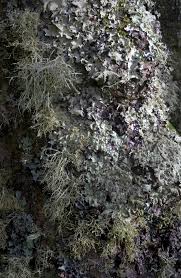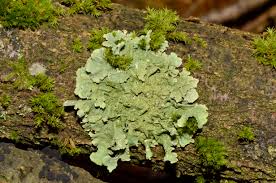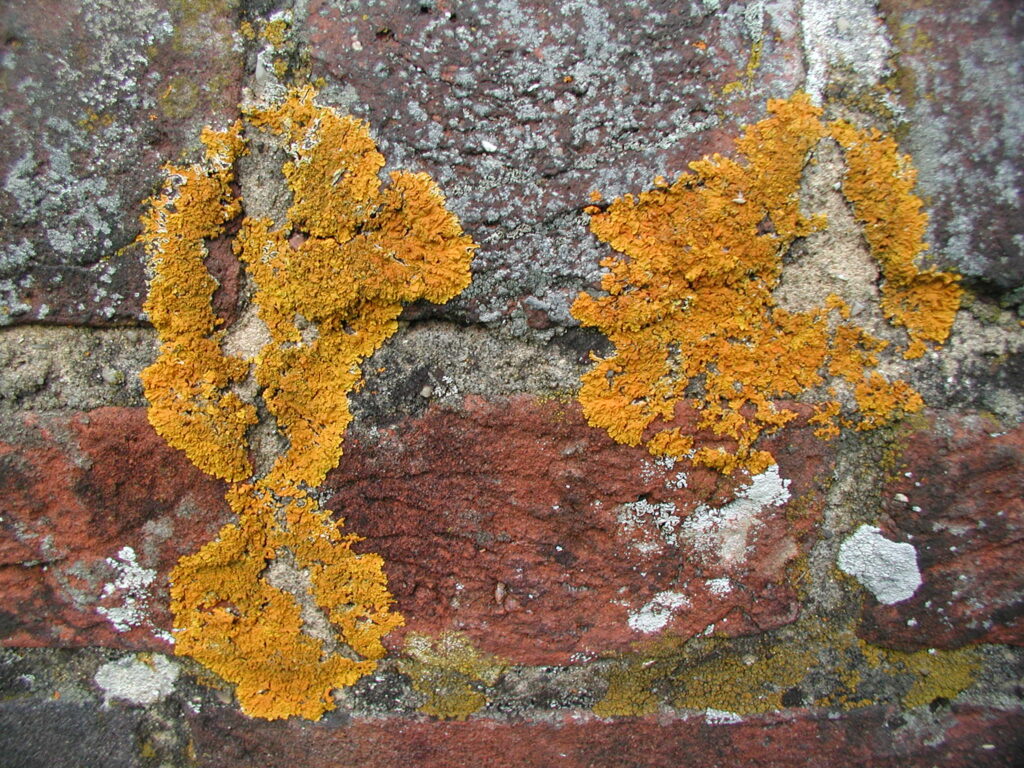lichens
- Lichens are dual (composites) or entities which contain a permanent association of a fungal partner or mycobiont and an algal partner or mycobiont.
- Mycobiont is dominant partner and mostly belongs to ascomycetes (Ascolichens- e.g. Graphis, Cladonia, Parmelia, Usnea etc) or sometimes basidiomycetes (Basidiolichens- e.g., Corella, Cora etc).
- Phycobiont is mostly a member of Chlorophyceae (e.g., Chlorella, Trebouxia, Protococcus, Palmella, etc.) or can be a BGA (e.g, Nostoc, Chlorococcus, Scytonema, etc).
- The term lichen was coined by Theophrastus (370-285 B.C) also called Father of Botany. Lichens often grow in most inhospitable and uninhabited places like barren rocks (sexicolours), soil (terricolours), icy tundra or alpines, sand dunes, roofs, walls, wood (lignicolours), tree bark (corticolours), leaves, etc. they commonly live under humid and exposed conditions but can tolerate extreme desiccation.
- However, lichens, cannot tolerate air pollution, especially due to sulphur dioxide (so are considered indicators of SO2 pollution). Lichens are perennial. Their growth is slow. Lichens have grayish, yellowish greenish, orange, dark brown or blackish colouration.
Lichens are fascinating composite organisms that emerge from a symbiotic relationship between a fungus and a photosynthetic partner, usually an alga or cyanobacterium. This partnership allows lichens to thrive in a wide range of environments, from the harshest deserts to the coldest Arctic tundras.
Structure and Composition
Lichens are structured in layers. The fungal component, called the mycobiont, provides the majority of the physical structure, creating a protective environment for the photobiont, which is either an alga or a cyanobacterium. The photobiont resides within the lichen and is responsible for photosynthesis, converting sunlight into nutrients that nourish both organisms..
Ecological Importance
Lichens play crucial roles in their ecosystems:
Lichens exhibit remarkable adaptations to survive extreme conditions:
- Desiccation Tolerance: Many lichens can survive prolonged periods without water, resuming normal functions when rehydrated.
- Symbiotic Efficiency: The mutualistic relationship between the mycobiont and photobiont enhances their survival in nutrient-poor environments.
In conclusion, lichens are extraordinary organisms that exemplify the power of symbiosis. Their ability to adapt and thrive in diverse and extreme environments, coupled with their ecological and practical significance, makes them a subject of ongoing scientific interest and admiration..

Structure .
The bulk of lichen body is formed by fungal partner called mycobiont. He algal partner or phycobiont constitutes hardly 5% of the lichens body
Types of Lichen Structures
- Crustose Lichens: These lichens have a thin, crust-like appearance and grow tightly attached to substrates such as rocks or tree bark. They often lack a distinct lower cortex and rhizines.
- Foliose Lichens: These lichens have a leaf-like structure with lobes that are loosely attached to the substrate. They usually possess both upper and lower cortices and have rhizines for attachment.
- Fruticose Lichens: These are bushy or shrubby lichens that can grow upright or hang from surfaces like trees. They often have a more complex internal structure and may feature a central core or axis for additional support.
Understanding the structure of lichens highlights their unique adaptations and the intricate symbiotic relationship that enables them to survive in diverse and often extreme environments.

The Symbiotic Relationship of Lichens
Lichens represent a remarkable example of symbiosis, a mutually beneficial relationship between two distinct organisms: a fungus (mycobiont) and a photosynthetic partner, which can be an alga or a cyanobacterium (photobiont). This partnership allows lichens to thrive in environments where neither organism could survive alone.
- Mycobiont (Fungal Partner)
- The fungal component typically belongs to the Ascomycota or Basidiomycota phyla.
- It provides the structural framework of the lichen, forming protective layers and creating a stable environment for the photobiont.
- The fungus also aids in absorbing water and nutrients from the surrounding environment, which it shares with the photobiont.
- Photobiont (Photosynthetic Partner)
- The photobiont can be a green alga (usually from the Chlorophyta group) or a cyanobacterium.
- It performs photosynthesis, converting sunlight into organic carbon compounds, primarily sugars, that feed both itself and the fungal partner.
- In some cases, the photobiont can also fix atmospheric nitrogen, providing an additional nutrient source.
- Environmental Tolerance: The partnership allows lichens to inhabit extreme environments, such as arid deserts, icy tundras, and nutrient-poor rocks. The fungal partner provides physical protection and moisture retention, while the photobiont enables energy production.
- Resource Utilization: Lichens can colonize surfaces where other organisms might struggle, contributing to soil formation and nutrient cycling in ecosystems. They play a role in breaking down rocks into soil through chemical and physical means.
Ecological and Biological Roles
- Pioneers of Succession: Lichens are often the first organisms to colonize bare substrates, initiating ecological succession and paving the way for other plant species.
- Bioindicators: Lichens are sensitive to air pollution and environmental changes, making them valuable bioindicators for monitoring ecosystem health and air quality.
- Symbiotic Versatility: Some lichens can switch photobionts depending on environmental conditions, showcasing an adaptive flexibility that enhances survival.
Conclusion
The symbiotic relationship in lichens exemplifies a complex and dynamic interaction that benefits both partners and allows them to thrive in various habitats. This relationship underscores the importance of mutualism and adaptability in ecological success, making lichens a significant subject of study in understanding symbiotic processes and environmental adaptation.

Funfacts:-
- Symbiotic Relationship: Lichens are fascinating examples of symbiosis, typically involving a partnership between a fungus and an alga or cyanobacterium. The fungus provides a structure, while the alga or cyanobacterium carries out photosynthesis to produce food.
- Pioneer Species: Lichens are often the first organisms to colonize bare rocks and other harsh environments. They play a crucial role in soil formation by breaking down rocks into smaller particles.
- Extreme Survivors: Lichens can survive in some of the most extreme environments on Earth, including arctic tundras, deserts, and even outer space! They have been found thriving in the harsh conditions of Antarctica and have endured exposure to the vacuum and radiation of space.
- Slow Growers: Lichens grow extremely slowly, often less than a millimeter per year. Some lichen species can be hundreds or even thousands of years old, making them some of the oldest living organisms.
- Air Quality Indicators: Lichens are highly sensitive to air pollution, particularly sulfur dioxide. Because of this, they are used as bioindicators to monitor air quality. A healthy lichen population indicates clean air.
- Diverse Colors and Forms: Lichens come in a variety of colors, shapes, and sizes, ranging from crusty patches on rocks to leafy, bushy structures hanging from trees. This diversity makes them an interesting subject for naturalists and scientists.
- Natural Dyes and Medicines: Lichens have been used historically to produce natural dyes for fabrics. They also contain compounds with antibiotic and anti-inflammatory properties, which have been utilized in traditional medicine.
- Photosynthetic Flexibility: Some lichens contain both green algae and cyanobacteria. These lichens can switch between these partners to maximize their photosynthetic efficiency under different environmental conditions.
- Unique Reproduction: Lichens can reproduce both sexually and asexually. They can form spores to produce new fungi that need to find their own photosynthetic partner, or they can reproduce by fragmentation, where pieces of the lichen break off and grow independently.
- Symbiotic Innovation: New research suggests lichens may involve more than just two partners. Some lichens have been found to include a second type of fungus, adding another layer of complexity to their symbiotic relationship.
Reproduction
Lichens multiply by four methods:-
(i) Progressive death and decay resulting in the separation of a lichen thallus into two or more parts.
(ii) Fragmentation caused by mechanical injury, due to wind or animal bites.
(iii) Isidia are superficial outgrowths of the lichens which are primarily meant for increasing surface area and and photosynthetic activity. At time, they are broken off . Each isidium is capable of forming a new lichen because it has a core of a algal cells surrounded by a sheath of fungal hyphae.
(iv) Soredia. These are most efficient means of asexual reproduction.
Reproduction of Lichens
Lichens, composite organisms formed by the symbiotic association between a fungus and a photosynthetic partner (alga or cyanobacterium), reproduce through several methods, encompassing both sexual and asexual strategies. These reproductive mechanisms ensure their survival and propagation across diverse and often harsh environments.
Asexual Reproduction
Asexual reproduction in lichens is the most common method and involves the production of vegetative propagules containing both the fungal and photosynthetic components. There are several forms:
- Soredia:
- Soredia are small clusters of fungal hyphae wrapped around algal cells.
- They are usually produced on the surface of the lichen and dispersed by wind, water, or animals.
- Once they land on a suitable substrate, they can grow into a new lichen thallus.
- Isidia:
- Isidia are outgrowths from the lichen surface that contain both fungal and algal cells.
- They can break off and disperse, forming new lichens upon finding a suitable environment.
- Unlike soredia, isidia have a protective outer layer, making them more robust.
- Fragmentation:
- Lichens can also reproduce by fragmentation, where parts of the lichen thallus break off due to environmental factors like wind or water flow.
These fragments, containing both fungal and algal cells, can establish new lichen colonies if they land in a conducive environment
Sexual Reproduction
Sexual reproduction in lichens involves the fungal partner, as it is the fungus that undergoes sexual reproduction. The photosynthetic partner does not participate directly in this process. Sexual reproduction occurs through the production of spores:
- Ascomycete Fungi (Ascolichens):
- Most lichens are formed by Ascomycete fungi, which produce spores in specialized structures called apothecia or perithecia.
- Apothecia are cup-shaped fruiting bodies that release ascospores into the environment.
- Perithecia are flask-shaped structures that also produce and release ascospores.
- Basidiomycete Fungi (Basidiolichens):
- Some lichens are formed by Basidiomycete fungi, which produce basidiospores on structures called basidia.
- These spores are released to germinate in suitable conditions.
Dispersal and Establishment
- Spore Dispersal: Fungal spores are typically dispersed by wind, water, or animals. Upon landing in a suitable location, the spores germinate and must encounter a compatible photobiont to form a new lichen.
- Compatibility and Symbiosis: Establishing a new lichen requires the successful formation of the symbiotic relationship between the germinating fungal spores and the appropriate algal or cyanobacterial cells. This process can be complex and is crucial for the lichen’s development.
Economic importance:-
(i) Early Colonisers:- Lichens are early or pioneer colonizers of barren rocks, cliffs, mountains and new terrains. During their growth, lichens stick ti the rocks and cliffs by secreting acids. It produces minute crevices where organic matter accumulates. It paves the way for growth of mosses.
(ii) Dyes:- Orchil is obtained from Rocella tinctoria. The latter was also the source of litmus (R. montagnel) before the advent of synthetic products. Litmus is a pH indicator.
(ii) air Pollution:- decrease in lichen population of an area is indicative of SO2 pollution.
Lichens are complex life forms that are a symbiotic partnership between a fungus and an alga or cyanobacterium. They function as a single organism and are distinct from both component organisms
Lichens can be found in a wide range of environments all over the world, including forests, deserts, tundras, rocky coastlines, and even in urban areas on walls and roofs.
Lichens can reproduce both sexually, through fungal spores, and asexually, through fragments of the lichen body that contain both the fungal and algal partners.
Lichens produce their own food through photosynthesis performed by the algal or cyanobacterial component. The fungus provides protection and structure, while the photosynthetic partner supplies nutrients.
- Lichens contribute to soil formation, provide food and habitat for various organisms, and are indicators of air quality due to their sensitivity to pollution.

2 thoughts on “lichens”